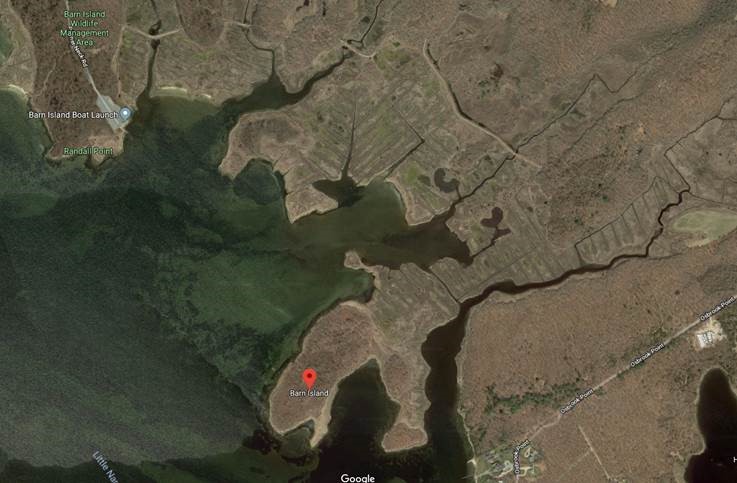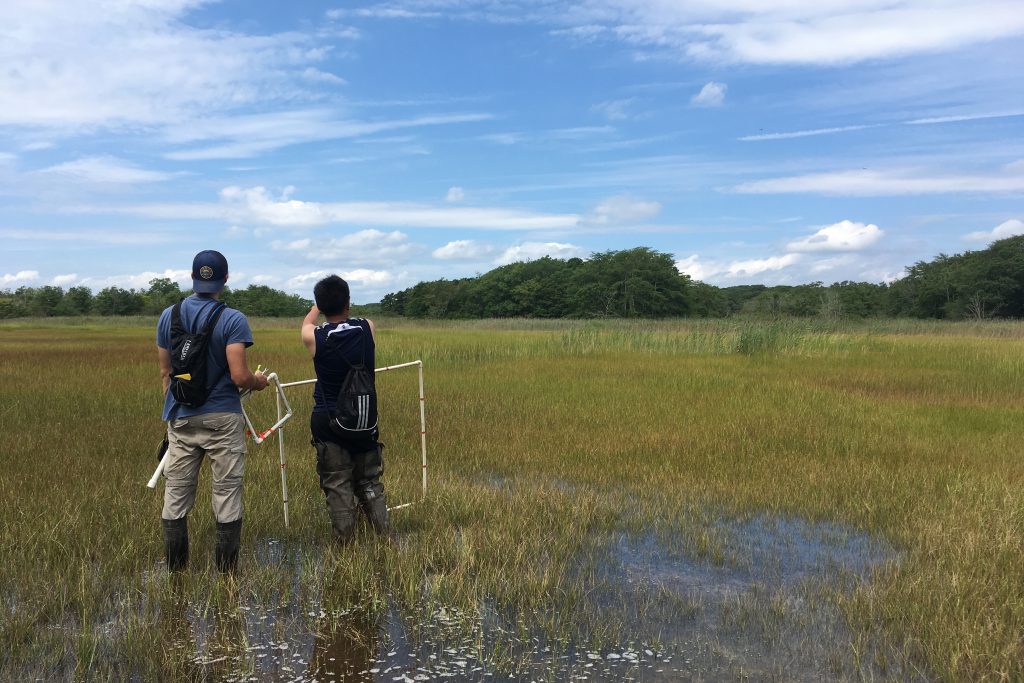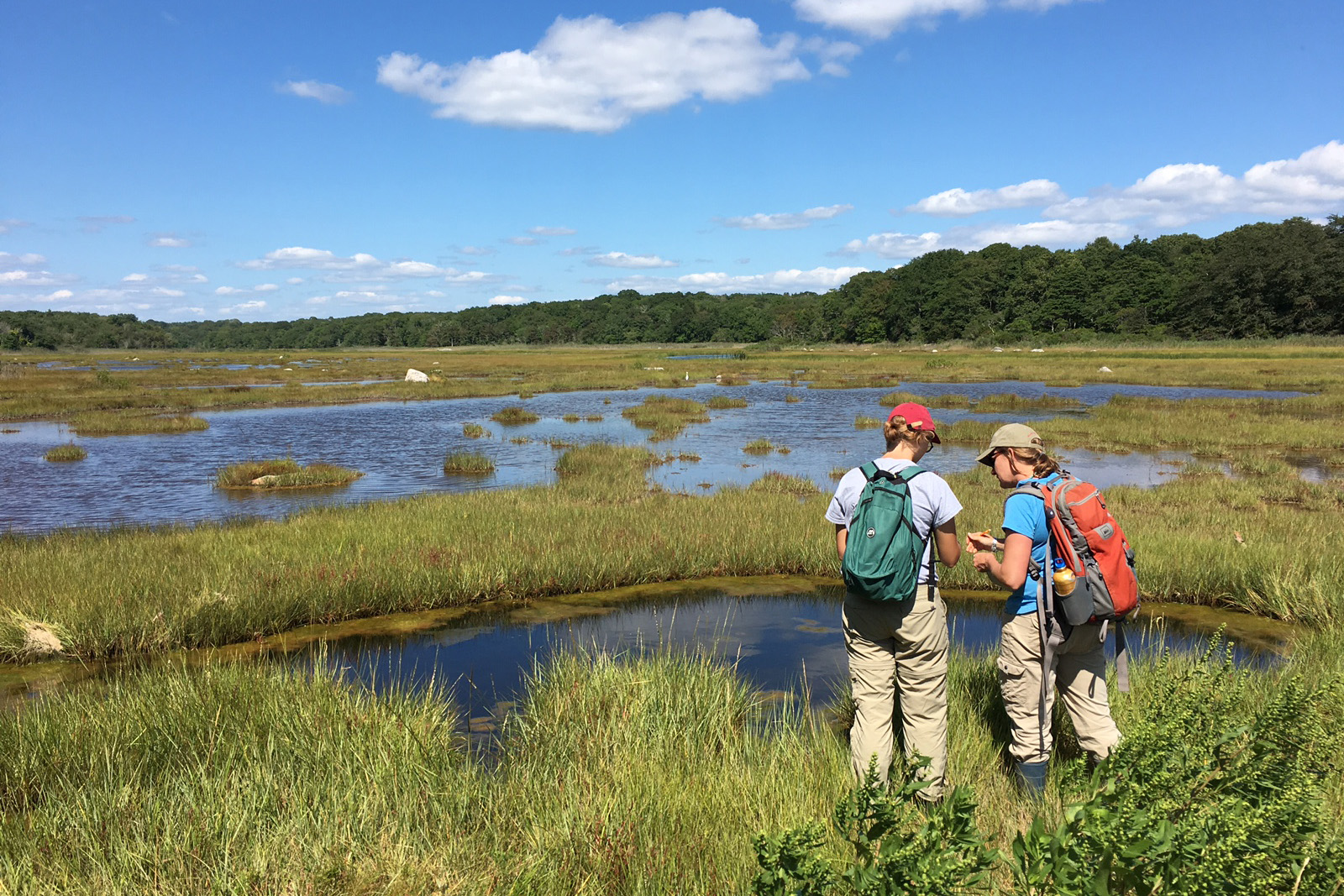A troubling report issued recently by the Intergovernmental Panel on Climate Change states that Earth is just two decades away from disastrously high levels of carbon in the atmosphere. As we approach those levels, there has been an increased focus on developing and using technology to sequester carbon dioxide from the atmosphere. Yet nature already has some effective means to accomplish this – wetlands and marshes.
Globally, wetlands and marshes are one of the largest natural sinks for carbon. — Ashley Helton
Two assistant professors in the Department of Natural Resources and the Environment, Ashley Helton and Beth Lawrence, are studying the processes that occur in these complex ecosystems. “Globally, wetlands and marshes are one of the largest natural sinks for carbon,” Helton says. “We want to quantify what wetlands are doing in terms of how they impact various ecosystem functions.”
To better understand carbon sequestration, think of marshes and wetlands as bank vaults; but rather than storing money, they store carbon. Plants living in the wet marsh environment pull carbon dioxide from the atmosphere and use the carbon to manufacture plant tissues, also known as biomass. As the dead plant tissues settle beneath the surface of the water, the biomass (i.e. the carbon) is deposited rather than broken down. This happens because microbes that are most efficient at converting the carbon-rich plant deposits back to carbon dioxide require oxygen, says Helton.
In a forest scenario, this sort of carbon-rich biomass is readily broken down by microbes. In aquatic marsh conditions, however, where there is less oxygen, these microbes cannot ‘spend’ the carbon, so the biomass simply accumulates, like a growing carbon savings account. Since the water level in marshes and wetlands typically remains high, the carbon is effectively prevented – or sequestered – from re-entering the atmosphere.

Helton says this is one of the reasons why wetlands and marshes are so important,
Wetland ecosystems haven’t always been valued. Once, they were viewed as negative elements of the landscape, deemed to be mosquito-ridden wastelands and home to scary swamp creatures. As a result, similar to how the region was deforested, many of the marshlands around the state were ditched and drained, as they were viewed as public health threats. In all, as much as 90 percent of Connecticut’s coastal marshes had been emptied by the 1940s.
“As the state became more developed, we filled the wetlands in, and altered the flow of water for instance, by building culverts that restrict tidal flow,” says Helton. “But later, we realized these wetlands served important functions.”
Marshes provide many ecosystem services. They are key habitats for wildlife, for instance. But when marshes and wetlands are drained, these ecosystem services are lost, including carbon storage. Not only do they stop sequestering more carbon, but they release most of the carbon that has been banked over the years.
Fortunately, efforts to restore Connecticut’s marshes began as long ago as the 1970s, and continue to this day.

Lawrence says the 1960s and 1970s brought a cultural mind-shift, with the start of the environmental movement. “People started to realize we need clean water, we need places for wildlife to live,” she says. “Society as a whole began to value the environment more. The focus was no longer solely on development and industrialization.”
In Connecticut, although the state is highly developed, there is also a high density of coastal wetlands and marshes. But these are still under threat from further development, an invasive plant species called Phragmites, and – increasingly – from rising sea levels.
“As the sea rises, the marsh vegetation cannot survive at those levels, so they migrate up in elevation,” says Helton. They eventually encounter invasive Phragmites, Connecticut’s steep topography, or built infrastructure. There isn’t a lot of room for the marshes to retreat, and they risk eventually being squeezed out of existence.
She says with rising sea levels, some of this saltwater marsh habitat will be lost.
If you drain or fill a marsh today, you don’t necessarily know what the implications will be 100 years later. — Ashley Helton
In the meantime, measures are underway to continue to restore marshes, such as combating the Phragmites directly. Helton says other means include efforts to restore the natural flow of water through the marshes. One of her areas of research is in large-scale restorations of tidal flow, and how the restoration impacts carbon and nitrogen cycling in the marshes.
“We know that when we restore these marshes, it increases habitat for wildlife and we are able to restore some of the native vegetation, but we don’t know what that does for the capacity of the wetlands to remove nitrogen or store carbon,” she says. “Those are some of the questions we are trying to quantify.”
Lawrence says they are also beginning to study how the restoration efforts impact the flow of saline water, as current models showing sea-level rise do not account for tidal restrictions like roads and other development. “If you imagine a two to three-foot culvert that may be installed under a road, for example, the water passing through that is very different from a free-flowing current of water. We are hoping to examine how tidal restrictions impact the marshes.”
Besides carbon storage, marshes are able to accumulate common urban contaminants, such as heavy metals, and store or remove excess nitrogen. These ecosystem functions are vital to improve water quality.
Helton, Lawrence, and their colleagues are doing what they can to learn about them before it’s too late, and to teach others through outreach efforts. Lawrence recently published a case study about the susceptible biota of saltmarshes, and the team is currently working on educational tools for high school students.
“We have local examples of how climate change is affecting our biological and ecological communities,” says Lawrence, “and they have an effect on our own well-being.”
Helton says it’s important to see the big picture. “If you drain or fill a marsh today, you don’t necessarily know what the implications will be 100 years later. Those are extremely important questions that we need to consider. What do our actions mean now, and what do they mean for the future?”
This work is supported by The Connecticut Sea Grant College Program (R/ES-26), the Long Island Sound Research Grant Program, and the Connecticut Institute for Resilience and Climate Adaptation at UConn.



